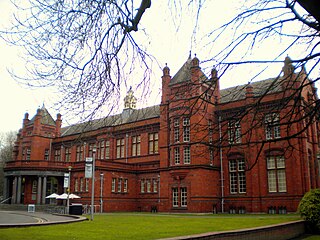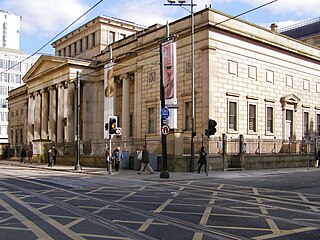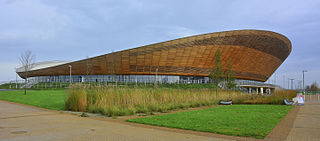
Dame Jocelyn Barbara Hepworth was an English artist and sculptor. Her work exemplifies Modernism and in particular modern sculpture. She was one of the few female artists of her generation to achieve international prominence. Along with artists such as Ben Nicholson and Naum Gabo, Hepworth was a leading figure in the colony of artists who resided in St Ives during the Second World War.

Tate St Ives is an art gallery in St Ives, Cornwall, England, exhibiting work by modern British artists with links to the St Ives area. The Tate also took over management of another museum in the town, the Barbara Hepworth Museum and Sculpture Garden, in 1980.

Dame Zaha Mohammad Hadid was an Iraqi-British architect.

The Whitworth is an art gallery in Manchester, England, containing about 55,000 items in its collection. The gallery is located in Whitworth Park and is part of the University of Manchester.

Manchester Art Gallery, formerly Manchester City Art Gallery, is a publicly owned art museum on Mosley Street in Manchester city centre. The main gallery premises were built for a learned society in 1823 and today its collection occupies three connected buildings, two of which were designed by Sir Charles Barry. Both Barry's buildings are listed. The building that links them was designed by Hopkins Architects following an architectural design competition managed by RIBA Competitions. It opened in 2002 following a major renovation and expansion project undertaken by the art gallery.

Sir David Alan Chipperfield is an English architect. He established David Chipperfield Architects in 1985.

Lee Valley VeloPark is a cycling centre on Queen Elizabeth Olympic Park in Stratford, East London. It is owned and managed by Lee Valley Regional Park Authority, and it was opened to the public in March 2014. The facility was one of the permanent venues for the 2012 Olympic and Paralympic Games.

Sir Colin Alexander St John ("Sandy") Wilson, FRIBA, RA, was a British architect, lecturer and author. He spent over 30 years progressing the project to build a new British Library in London, originally planned to be built in Bloomsbury and now completed near Kings Cross.

Pallant House Gallery is an art gallery in Chichester, West Sussex, England. It houses one of the best collections of 20th century British art in the world.
Rick Mather was an American-born architect working in England. Born in Portland, Oregon and awarded a B.arch. at the University of Oregon in 1961, he came to London in 1963 where he became a leading figure at the Architectural Association in the 1970s, and in 1973 founded his own practice, Rick Mather Architects.

Fuglsang Art Museum is an art museum set in rural surroundings in Guldborgsund Municipality on the island of Lolland in Denmark. It is part of the Fuglsang Cultural Centre. The museum features Danish art with an emphasis on artists and motifs of local provenance.

The Hepworth Wakefield is an art museum in Wakefield, West Yorkshire, England, which opened on 21 May 2011. The gallery is situated on the south side of the River Calder and takes its name from artist and sculptor Barbara Hepworth who was born and educated in the city.
The year 2011 in architecture involved some significant architectural events and new buildings.
Allford Hall Monaghan Morris is an architecture practice based in Clerkenwell, London, with offices in Bristol and Oklahoma. Set up in 1989 by Simon Allford, Jonathan Hall, Paul Monaghan and Peter Morris, the practice employs over four hundred people working on projects in Education, Healthcare, Housing, Arts and Offices.
The Designation Scheme is an English system that awards "Designated status" to museum, library and archive collections of national and international importance. The Scheme is administered by Arts Council England (ACE). As of 2018, 148 collections are officially designated, with 140 recognized as 'outstanding'. National museums are not eligible for Designated status.

Brockholes is a nature reserve near Preston, Lancashire, England, just off Junction 31 of the M6 motorway. It is owned by the Wildlife Trust for Lancashire, Manchester and North Merseyside. Situated in the flood-plain of the river Ribble, it has the UK's first floating visitor village.

van Heyningen and Haward is an architectural practice, founded in 1983 by Birkin Haward and Joanna van Heyningen, and now owned and managed by James McCosh, Meryl Townley and Chris Wilderspin. The London architects work primarily in education, and have also worked in the heritage, community and health sectors.
Philip Dalton Hepworth was a British architect. He studied in both the UK and France, at the Architectural Association School of Architecture and the École des Beaux-Arts, and returned to work as an architect after serving in the First World War. He rose to prominence in the 1930s, featuring in a book by architectural critic Trystan Edwards and winning the commission in 1932 to design Walthamstow Town Hall, which was eventually completed in 1942. He lived in Zoffany House in Strand-on-the-Green, Chiswick, London, from 1936.
Hugh Giles Keyworth Broughton is an English architect and one of the world's leading designers of polar research facilities. His practice, Hugh Broughton Architects, was founded in 1995 and is based in London, works internationally. The practice has won several high profile international design competitions, including Halley VI Research Station, Juan Carlos 1 Spanish Antarctic Base, the Atmospheric Watch Observatory in Greenland for the US National Science Foundation and a new health facility on Tristan da Cunha, the world's most remote inhabited island. The practice has received numerous international awards including a RIBA National Award 2016, The American Prize for Architecture 2016, Civic Trust Award Special Award for Sustainability 2014, RIBA International Award 2013, three AJ Retrofit Awards in 2013, and BD International Breakthrough Architect of the Year Award 2012
















